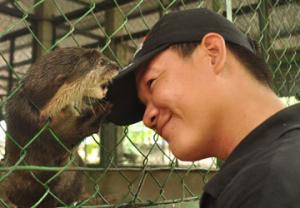Rescuing wildlife: the family of water rats (Part 1)

The Cu Chi Wildlife Center is now saving 1500 individuals of wildlife, including the rare species which are on the verge of extinction.
The habit of hunting rare birds and animals and eating the food made of wild animals has pushed many rare species to the brink of extinction. In this context, the efforts by animal rescue centers to save the animals are described as the scream to awaken people’s conscience.
Established in 2006, the Cu Chi Wildlife Center has rescued and returned 2000 wild animal individuals to the wild so far. The center is rescuing 25 species with 1500 individuals, including the rare and valuable which are on the verge of extinction. This is considered the biggest wildlife’s hospital in the south, where some individuals have reproduced and the next generation of animals has turned up here.
The two sour and scornful water rats girls
Tran Anh Tu, an officer of the Cu Chi wildlife rescue center, said he remembers well, the sleepless night he spent to keep watch over the two young water rats and fed them with milk powder. The two water rats were brought by a foreign girl, named Kenlly, after she bought them from a vendor in ${bigcity_Ho_Chi_Minh_City:”Ho Chi Minh City”}.
When the water rats were brought to the center, they cried out because they were hungry. The center’s officers had to make the formula and pour into the feeder for the water rats. When they got filled up, they lied sprawled out and stopped crying.
Since that day, the two water rats had been fed with the milk powder prepared by the center’s officers. They had to take turns on duty to prepare milk and take care for the otters. Sometimes they had to feed the otters for four or five times. The infant otters cried every time they felt hungry.
“They look nice like the children, and we have become babysitters unwillingly,” Tu said.
As Tu and Seaman, a foreign specialist of WAR (Wildlife At Risk) organization, had to stay late at night to take care and feed the otters, the center named the otters with the names of Tu and Seaman.
When the otters grow up, Tu and Seaman were fed with fish and trained how to hunt for food. The two girls gradually learned to hunt skillfully. When Tu and Seaman enter the puberty period, they get hard to be pleased.
The center’s officers tried to pair Tu and Seaman and other otters, but they failed. However, one day, a big otter boy chased the two girls and they became the members of the same family.
The officers at the center really did not want the two otters to reproduce at the center because they would be better to reproduce on the deep water and desolate areas. Therefore, the officers did not know about the pregnancy of Tu.
One day, when an officer came to feed the two otters, he discovered three new members in the otters’ family
The young otters really surprised the officers of the center, because no one could imagine one day that otters can give birth in such a condition.
When reporters came to center, the otters were still in the childbirth; therefore, the reporters could not take the pictures of the otters. “Otters, when giving birth, always choose the desolate, quiet places with little light. Male animals always sit up with the children when they can feel danger, so that the female animals can take their children away.
As such, the young otters will not have to live away from their mothers. They will not be traded and fed with milk, like Tu and Seamand. The life of otters which were thought on the verge of extinction has entered a new development period.









